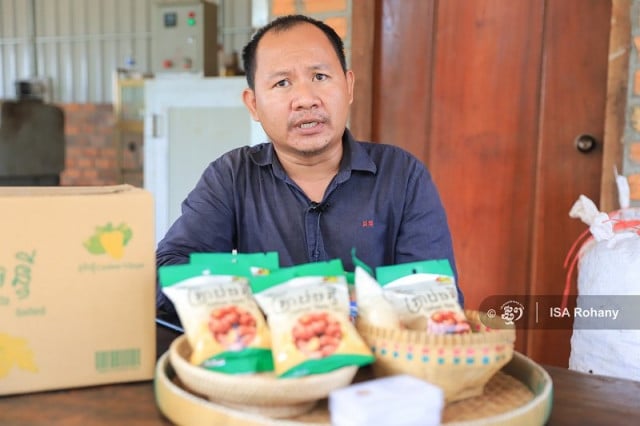Siem Reap Chef Blends Cambodian Food to Foreign Tastes

- By Torn Chanritheara
- April 13, 2024 2:30 PM
SIEM REAP – In his Siem Reap city restaurant, chef Duk Deth is showing off local cuisine to foreigners by finding what they like: boneless food with less non-edible decoration.
At the Butterfly restaurant, Deth said he prepared Khmer food to suit foreigner tastes by using fewer ingredients or decorations.
Before cooking, he has bones removed because foreigners don’t like meat with bones.
“Everything on their bowl can be eaten,” he said.
He said that most foreigners order amok, curry soup and teuk kreung — Khmer fish dip with vegetables. Although the food is changed to suit foreigners’ tastes, the price remains the same at between $4 and $5.
Deth said restaurants must understand what their customers want. If their target is Western tourists and the food has a more Asian taste, it won’t succeed.
 Deth said he prepared Khmer food to suit foreigner tastes by using fewer ingredients or decorations. Photo: Lay Long
Deth said he prepared Khmer food to suit foreigner tastes by using fewer ingredients or decorations. Photo: Lay Long
“Most tourists want to taste Khmer food when they come since they have their food in their countries already. So, we need to prepare food that enables them to eat conveniently,” he said.
“If we cook like we do at our home, it will be difficult for them.”
A chef needs to know that and cook and garnish food in line with that, he said. Fish or chicken bones must be removed when served and any inedible spice used in curry should be picked out.
He said many inedible decorations on the food might make the customer upset when they pay to eat.
Deth said some foreigners order the same food three days in a row. Most of his customers are Australian, German, French or American.
In his experience, foreigners like Khmer food because it is not spicy or salty and less sweet.
 Most of Deth's customers are Australian, German, French or American. Photo: Lay Long
Most of Deth's customers are Australian, German, French or American. Photo: Lay Long
Deth’s culinary journey
Deth now owns three restaurants in Siem Reap. Butterfly, opened in 2006, is where he started his journey. But his voyage goes back far earlier.
He is the eldest child from a poor family in Takeo province. He moved to Phnom Penh in 1993 and had the opportunity to live in Child’s Smile or Pour un Sourire d'Enfant (PSE), a non-governmental organization where he learnt cooking skills until 2005.
After leaving PSE, he worked at a hotel in Siem Reap for a year. He met a US man who wanted to open a restaurant and decided to open Butterfly Garden which has been operating ever since.
“Without PSE, I will not be who I am today. I might have been a garbage collector. The knowledge I have today is from PSE,” he said.
Deth said he has joined many PSE’s activities to show his gratitude to the NGO.
He said that everything started from scratch at Butterfly while he and the US owner worked side by side to keep the restaurant running. He worked as a staff member and as a chef for ten years before finally being promoted to manager.
 Deth is the eldest child from a poor family in Takeo province. Photo: Lay Long
Deth is the eldest child from a poor family in Takeo province. Photo: Lay Long
Since he was a part-owner, he got a share of the profits which he used to buy the restaurant when his partner decided to go back to the US.
“He asked me why I wanted to buy. I replied: we started it together. I wanted to keep it alive forever,” he said.
“Even in COVID-19 pandemic, I tried hard to keep it.”
Deth also owns two other restaurants in Siem Reap, one of which focuses on local customers. The three restaurants employ about 20 people.
He recalled the hardship he faced during the pandemic when he struggled to keep the restaurant running. He said that it would have been easy to close the business but all the staff who had worked with him for years would have been affected.
He said that he could not leave them behind. During the pandemic, Deth said he needed to find some income to overcome the difficulties and keep the restaurant alive and help the staff.
“If we had closed, they would have found new places. But other restaurants also closed. So, their skill would have been lost since they needed to change skills and work at other places as construction worker,” he said.















